Baby Desert Tortoise Care: Info You Must Incorporate
Petting desert tortoises (Gopherus agassizii) is always advantageous. It lets you witness their adorable behaviors while learning crucial lessons about desert ecosystems. We assume you are starting your petting journey by taking home a baby version of this incredible creature.
But how to perform baby desert tortoise care? In caring for this tiny captive, you are entitled to perform various tasks, such as providing the right enclosure, diet, etc. Also, you need to address health issues, daily interaction with it, and so on.
In this article, we detail these needed actions to make you understand how to ensure its health and well-being. Let’s dive in.
Proper Environment for Baby Desert Tortoises
Contents
Providing a suitable habitat is vital for the well-being of baby desert tortoises. Keep the following considerations in mind while you establish the enclosure.
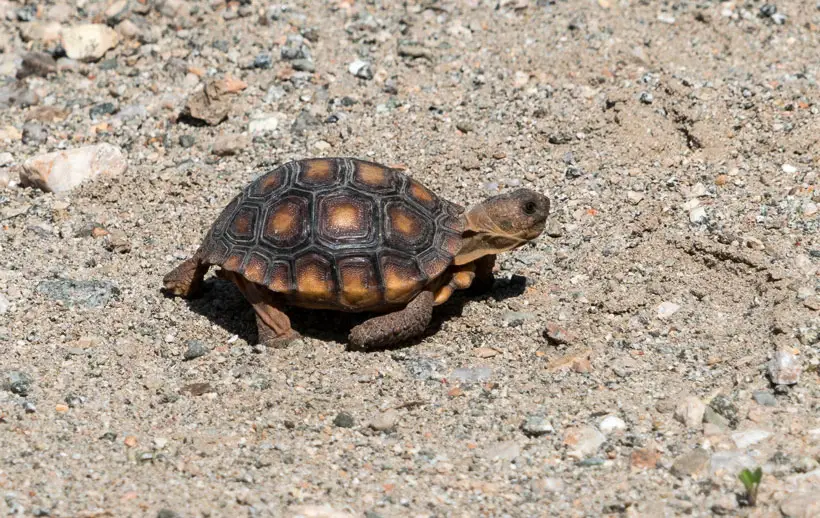
Size and Space
Though baby desert tortoises are tiny, they need ample space to move and explore. Provide a habitat enclosure that allows them to roam freely while exhibiting natural behaviors.
Generally, a tortoise enclosure should be at least ten times the length of the tortoise’s shell. However, you must ensure a size of 3 feet X 2 feet X 8 inches (LXWXH) for keeping a baby tortoise.
Fencing and Boundaries
Ensure the enclosure has sturdy walls or fences to prevent escapes and protect the tortoise from potential predators. In this case, if the enclosure is a tortoise pen on the natural ground, you must ensure that the walls are buried at least six inches deep to deter burrowing.
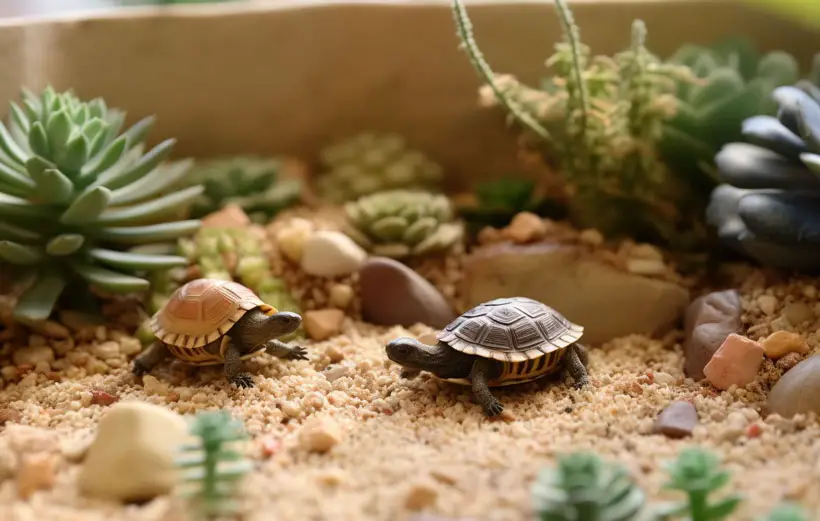
Substrate
Choose a suitable substrate for the enclosure, such as a mix of soil, cypress mulch, coconut fibers, etc. These allow for natural digging behavior and help maintain appropriate humidity levels. We suggest you use natural soil if you provide your pet with an outdoor living facility.
Shelter and Hiding Places
Provide shelters and hiding places like logs, rocks, or small plants to offer protection and a sense of security for the baby tortoise.
Temperature and Lighting
Maintaining an appropriate temperature within the enclosure is crucial. You must empower the enclosure with a warm basking area and a cooler retreat.
Considering temperature regulation, accommodate a warm area ranging from 80 to 90°F. And a cooler section with temperatures between 70 to 75°F to avoid the risk of excessive heat. Use a combination of natural sunlight and artificial UVB lighting to meet their heat and lighting requirements.
Lastly, maintain a humidity level of around 30 to 40%. And be careful to restrict the inclusion of excessive humidity, as it can lead to respiratory problems.
Facilitating a Balanced Diet
Providing a balanced diet is essential for the healthy growth and development of your baby desert tortoises. Its diet should consist of various foods that meet their nutritional needs.
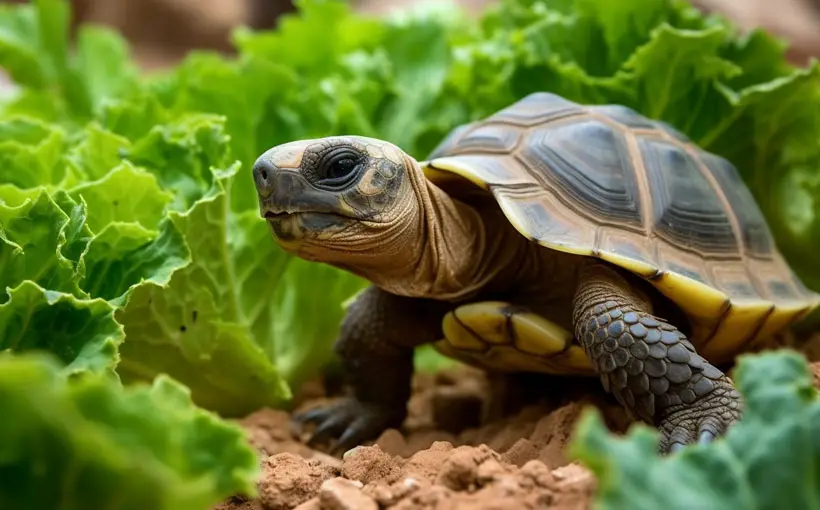
The below table contains the related dataset in terms of feeding this species.
| Food types | Example |
|---|---|
| Leafy Greens | kale, collard greens, dandelion greens, and mustard greens |
| Hay and Grasses | Timothy or Bermuda grass |
| Vegetables | Squash, bell peppers, carrots, etc. |
| Calcium-Rich Foods | Reptile supplements, cuttlebone, or crushed eggshells |
| Fruits | Strawberries, melons, apples, etc. |
| Supplements | Reptile-specific multivitamins and mineral supplements |
Must-Consider Measures
Below are measures you must consider in terms of feeding the baby desert tortoises.
- Offer fresh food daily and remove any uneaten portions to prevent spoilage.
- Feed two times: morning and afternoon.
- Provide a shallow dish of fresh water at all times, ensuring it is easily accessible for the tiny species.
- Go for a varied diet to ensure a broad spectrum of nutrients.
- Observe the tortoise’s eating habits and adjust the portion sizes accordingly.
Health Issues and Addressing Approaches
Maintaining the health and hygiene of your baby desert tortoise is more than essential to trigger overall well-being. To protect the pet from potential health issues, you have to be attentive to their needs while providing proper care.
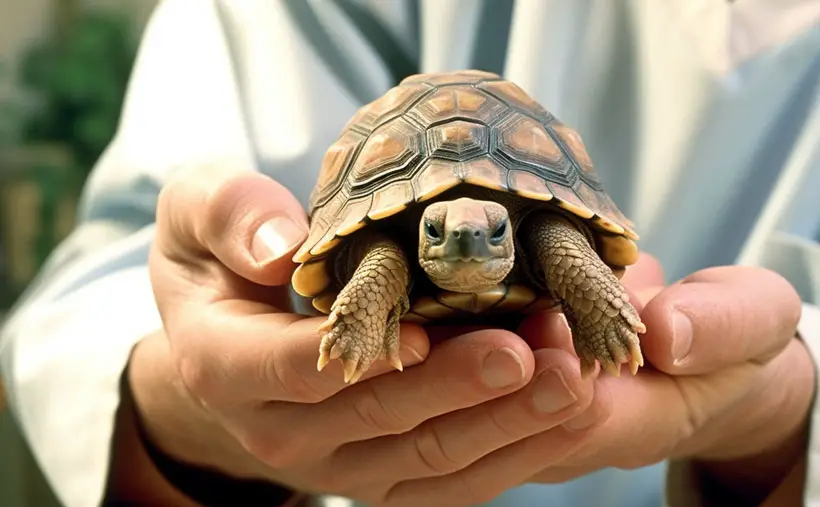
Below are some common health issues of desert tortoises. If you notice any of them in your baby pet desert tortoise, consult a vet as soon as possible.
- Respiratory Infections: Respiratory infection orientation is very common in desert tortoises. And your little friend is also vulnerable to this threat. The symptoms of this health issue include wheezing, discharge from the nose or eyes, or lethargy.
- Shell Issues: Problems like uneven shell growth, shell rot, or cracks may occur. To address shell-related issues, you have to consider its nutrition seriously. Especially, you must ensure the daily diet contains an adequate amount of calcium and vitamin D3 for the pet.
- Parasites: Internal and external parasites can affect tortoises. Regular fecal exams can reveal whether your tiny pet is accommodating any parasites or not. If the creature’s body accommodates parasites, consult the vet and check for lacings in its hygiene.
- Dehydration: Monitoring and facilitating appropriate hydration levels is crucial for the pet’s healthy living. We suggest you keep shallow water storage inside the enclosure and always ensure access to clean and fresh water. Provide regular baths to aid hydration and promote proper shedding.
However, always use clean and room-temperature water to soak the baby desert tortoise. As per standard, you should soak the hatchling daily at first and later on every other day for a total of around 20-30 minutes weekly.
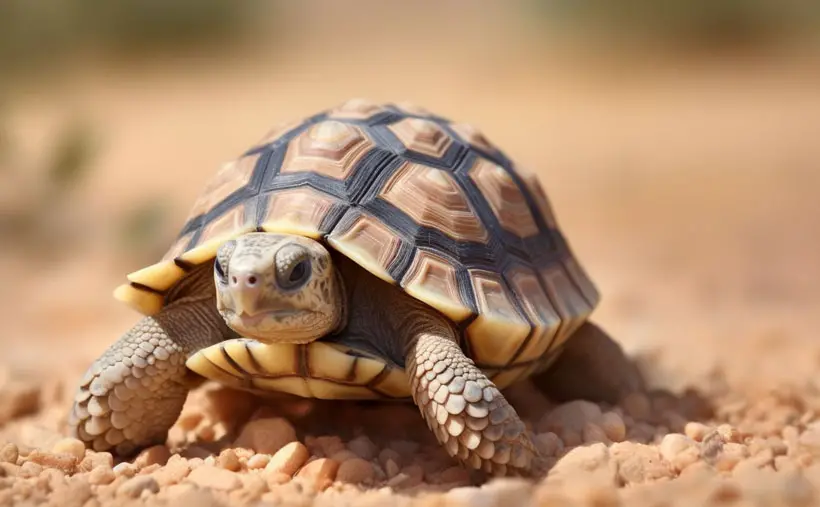
Regular Veterinary Check-ups
Regular veterinary check-ups are essential to monitoring the overall health of your baby desert tortoise. Undeniably, a reptile veterinarian is always better than you at conducting physical examinations, checking for potential health issues, etc.
Follow your veterinarian’s recommended schedule for check-ups and vaccinations based on the specific needs of your tortoise.
Check out this YouTube video to learn more about the baby desert tortoise care process.
People Also Ask
Here, we answer some of the most common questions regarding baby desert tortoise care.
By the natural rule, tortoise mothers do not contribute to their babies’ care. The mother’s responsibility ends at the point of laying the eggs. So, you can say baby desert tortoises stay with their mother for zero days.
For in-house inhabitants, it is not that tough. However, you must keep the tortoise enclosure out of the dog or cat’s reach. And for outdoor habitat, the enclosure must be empowered by hard roofing and chicken-wire fencing.
As per the fundamental understanding, tortoises are more inclined to be herbivores. Following this, the baby desert tortoises live on vegetables. But, to meet the protein requirement, they may rarely eat dead animals’ meat.
Final Words
Indeed, observing the activities of baby desert tortoises is always fun. The journey from babyhood to adulthood with the tortoise is fascinating and a great contribution to this species’ conservation.
In this way, having an in-depth understanding of baby desert tortoise care allows you to embrace the responsibility of being a steward of nature.
Here, the knowledge about creating a suitable habitat, providing a balanced diet, and maintaining their health and hygiene are the most important ones. Lastly, though many tortoise lovers prefer outside habitats for their pets, we strongly discourage such living for baby tortoises.

